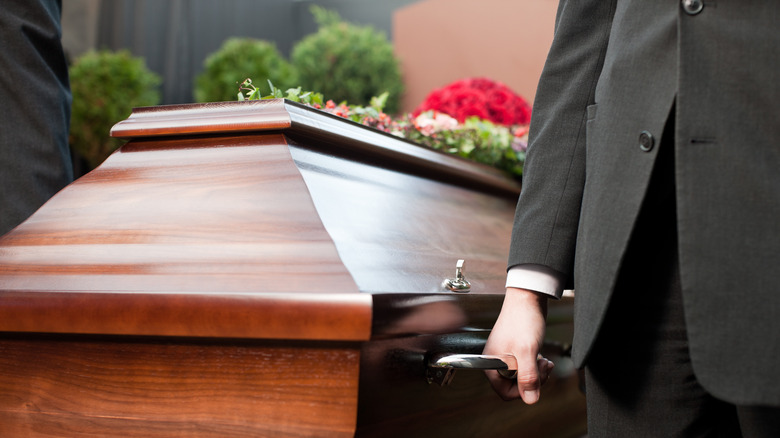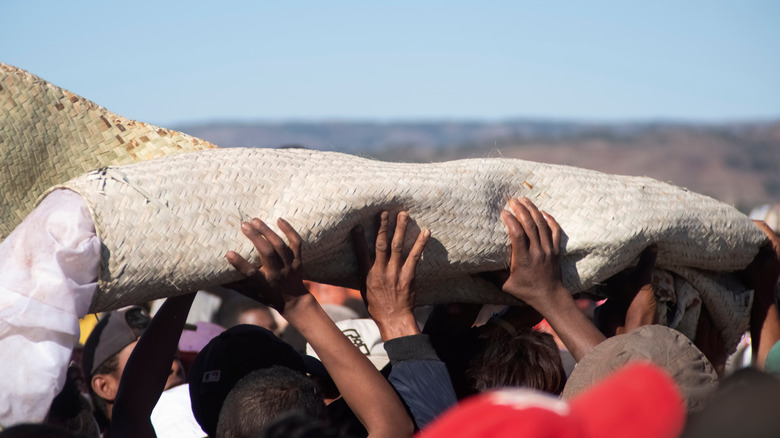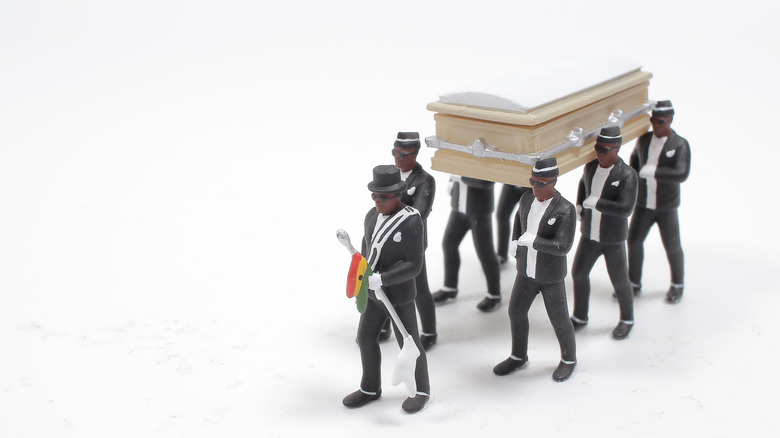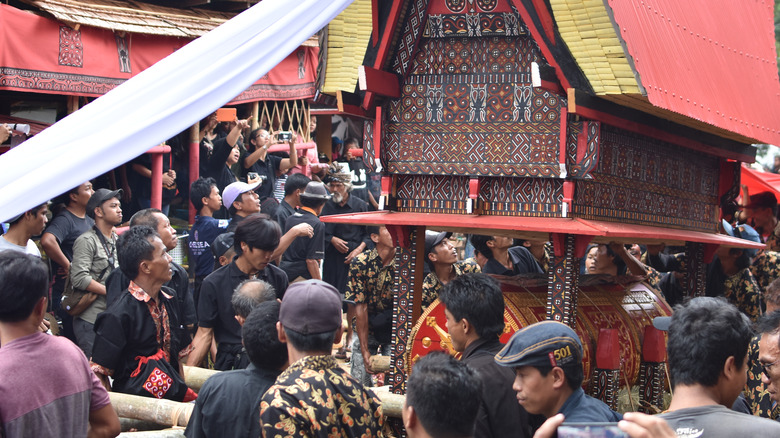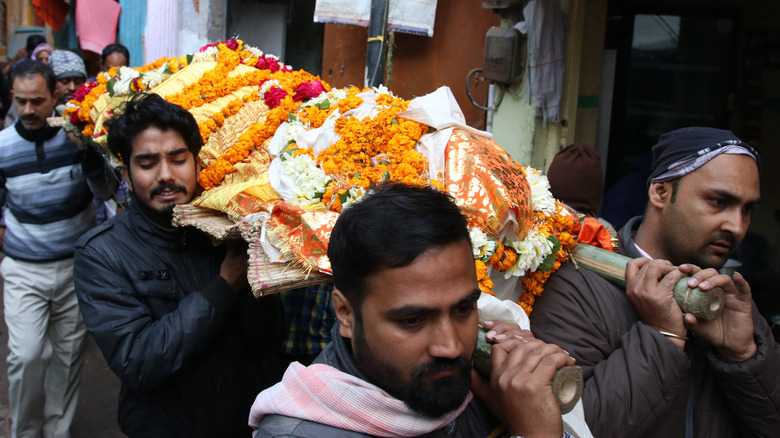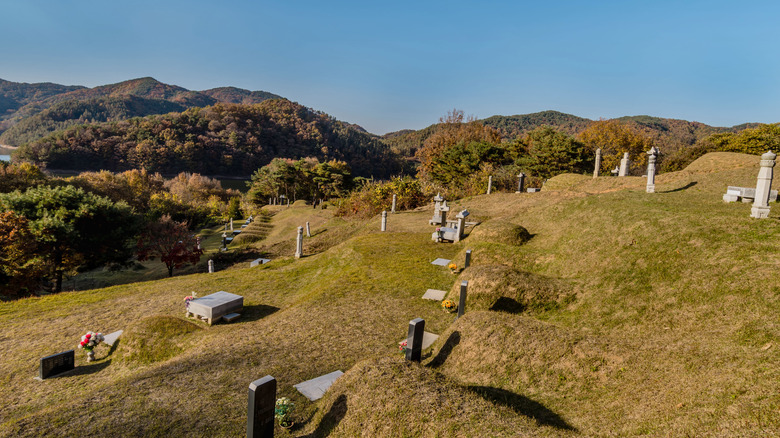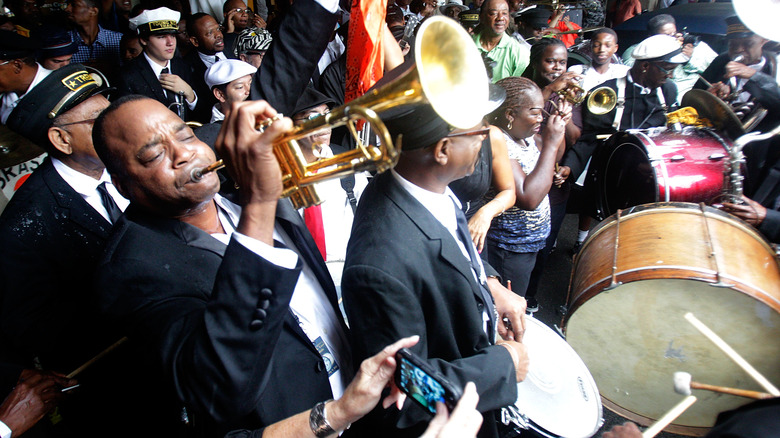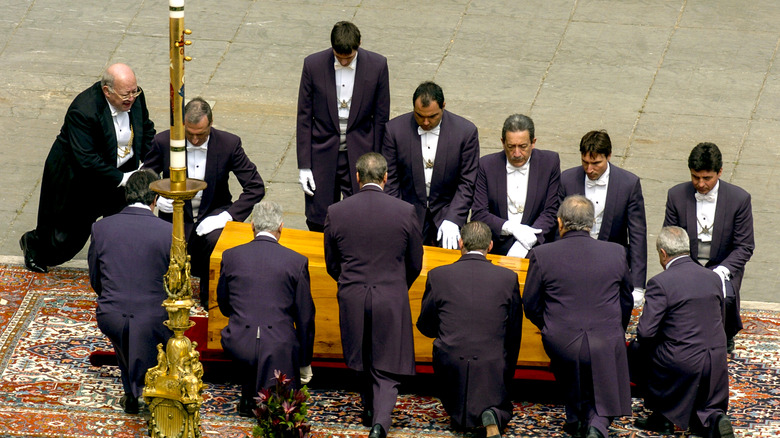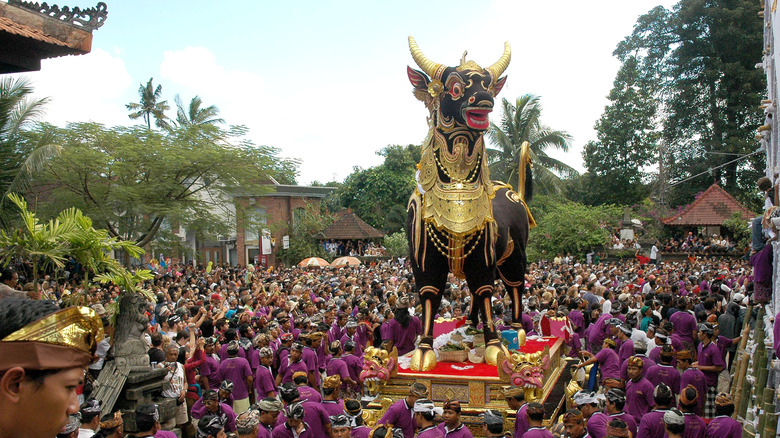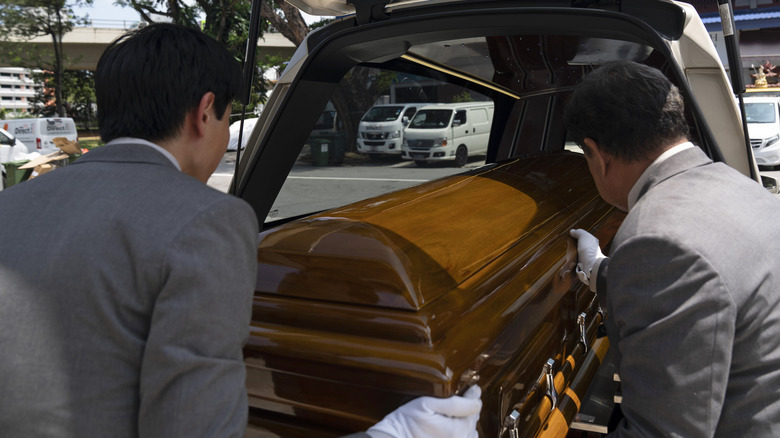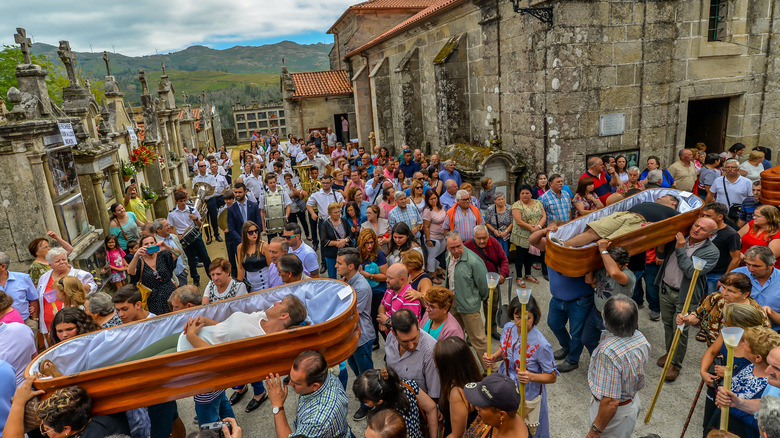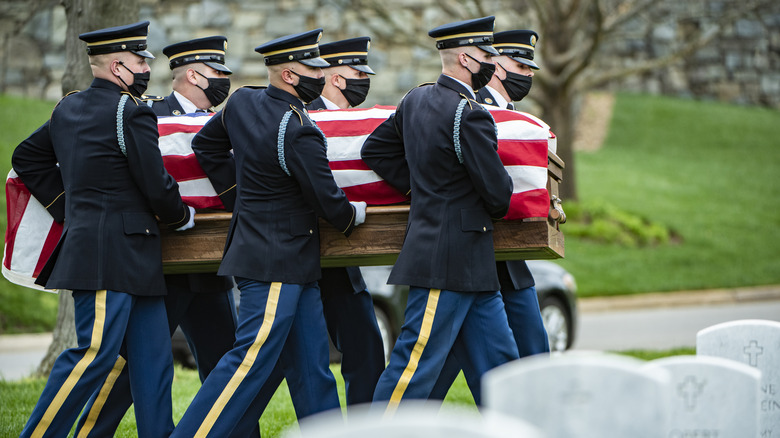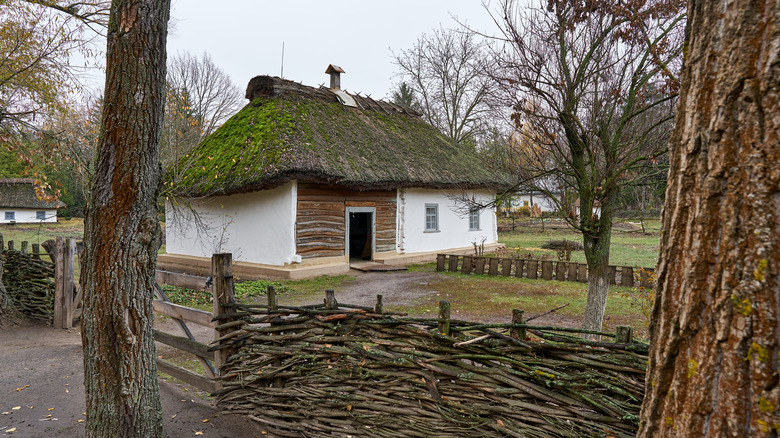Pallbearing Traditions From Around The World
In general terms, a pallbearer is usually thought of as anyone who helps to carry a coffin, though it can also refer to a member of the funeral procession or honor guard who escorts the dead. For most in the western world, it likely conjures up an image of six somber people in suits shouldering the casket of a close friend or relative — but around the world pallbearing traditions are as diverse and fascinating as any other death ritual. Every aspect of funeral traditions are steeped in cultural heritage, and how people choose to carry their family members from their homes to their final resting places is no exception.
Some choose to carry a coffin with viral dance moves while others are hunched under platforms that weigh six times the weight of a standard car. Some lament loudly enough to get their rituals banned in most funeral homes, while still others send their loved ones to the grave with cheers and music. Here are just a few pallbearing traditions from around the world.
Madagascar – Dance with the Dead
Considering pallbearing is generally the means of getting a casket to the gravesite, one might assume that by definition it takes place before burial — but that isn't the case for some in Madagascar.
A sacred ritual called Famidihana (turning of the bones) that has been practiced since the 17th century, says The Vintage News, calls for the bodies of ancestors to be exhumed for their crypts. Far from being a solemn task, this event is a celebration that many travel from miles around to experience. It occurs approximately every five to seven years, depending on when an ancestor appears to a senior family member in a dream. During the festival, the living carry the dead through the community to experience the festivities alongside them. They drink with them, talk with them, and even help their departed ancestors to join in the dancing.
"[Famidihana] is a moment of happiness and joy and sadness is not allowed," said historian Andrianahaga Mahery in an interview with CNN.
Before sunset, the bodies are returned to their resting places but placed back in a new position. It is believed that they will not completely move on to their next life until they completely decompose, so they will await the next "turning of the bones."
Ghana – Local Funeral Customs that Went Viral
The Nana Otafrija pallbearers of Ghana first went viral for their dance moves in 2017, reports The Guardian. They inspired homage performances all over the world, from police in Peru to protestors in Lebanon. There are even toys based on them. They enjoyed another burst of fame during COVID-19 when the world was looking for death-themed memes to express themselves. Dropping to the ground and dancing with a coffin almost crushing you was the exact right combination of absurd and morbid for the moment.
The "coffin dance" tradition itself is actually a new one. While Ghanian funerals are important social occasions, and they have gained international attention for other flashy practices, (including some artisan coffin-makers creating coffins that reflect the interests of the dead, resembling things like coke bottles, planes, and even a uterus) dancing pallbearers are the brainchild of one man.
Benjamin Aidoo, self proclaimed, "number one dancing pallbearer in the world," is the founder. This tradition developed as a response to the desires of clients. He stated to the BBC that he would ask family members of the deceased, "Do you want it solemn or do you want a bit of a display? Or maybe you want some choreography on it?"
These funerals are growing in popularity, and Aidoo has created more than 100 jobs for new Dancing Pallbearers.
Toraja, Indonesia – Keeping the Dead at Home
In the United States, most pallbearers have the duty of escorting their loved one to the burial site within about a week of death. For the Torajans in Indonesia, the funeral procession is an event that concludes a months-, or even decades-long ritual.
When a person dies, their body is kept at home and cared for by their relatives as if they were ill. The body is offered food, water, and anything else they would've wanted in life, such as cigarettes, because it is believed that their spirit is still present. Friends and family will see their loved ones again, however. Approximately every two years the family returns to unearth the bodies and give them a fresh change of clothes.
The corpses may remain in the home for years. A major factor in the length of their post-mortem stay? Cost. According to Vice, the funeral procession can cost anywhere from $50,000 to $500,000. That doesn't include the cost of sacrificial water buffalo.
During the funeral procession, known as Rambu Solo, the buffalo are sacrificed. With the "last breath" of the animals, it is believed that the person truly dies as well. From here, the animals take up the burden of carrying the spirit of the dead, while their family members parade the body on to their mausoleum. The more buffalos are sacrificed, the faster the soul reaches heaven, with 24 being an optimal number.
Varanasi, India – Intimate Rituals of Death in Public
In a city that dates back to the second millennium B.C.E., notes Britannica, and has been called the spiritual capital of Hinduism, death is a part of life.
In Varanasi, India, bodies are paraded through the streets to reach the sacred river Ganges. They are met with cheering and chanting. Every day at Manikarnika Ghat, the largest of the cremation Ghats along the edge of the Ganges, more than 100 bodies are burned on its pyres, according to Atlas Obscura. Its flame has been burning all day and all night for centuries.
The celebratory nature of the funeral procession makes sense once you understand the high demand for dying in Varanasi. It is believed that those lucky enough to die in the holy city attain Moksha, release from the cycle of rebirth. One could argue that the living serve as their own pallbearers, as, according to Times of India, thousands of people nearing the end of their lives travel to Varanasi each year in hopes of dying in the city.
Korea – an Old Tradition that Continues to this Day
Elaborate Korean funeral traditions have become less popular in recent decades due in part to their difficulty and complexity — although they endure in remote areas of South Korea.
Easily the most recognizable component is the funeral procession that is accompanied with song. The coffin is carried to the gravesite on a colorfully painted and intricately carved bier. The pallbearers march to the beat of drums, wearing hemp garments and tall matching hats, and repeat lines sung by a funeral singer — the "bawijeol hosangnori" or regional "funeral song."
The funeral singing itself can cause problems in a modern world. Other than the sheer difficulty of finding someone with the skills and knowledge, the proximity of contemporary funeral halls prevents mourners making too much noise of any kind — meaning that traditional singing is prohibited. According to The Korea Herald, Hwang Jeong-seop, head of the local association for the preservation of funeral song, has stated that one of the biggest barriers to passing on the funeral tradition to younger generations is that it is more difficult to learn, and they simply aren't interested in tradition. "To carry the coffin is difficult so they don't want to do that," he explains.
In order to keep the tradition alive, his association voluntarily performs these funeral processions free of charge.
New Orleans, USA – The Jazz Funeral
The city of New Orleans is famous for its food, its music, and of course for the culmination of carnival season — Mardi Gras. A lesser known but equally deeply rooted city tradition is the jazz funeral and the "second line" procession.
A modern jazz funeral consists of a brass band escorting the dead from the church to the cemetery, as well as a "second line" of well-wishers, sometimes in costume that follow the casket from the church to the graveyard, as if in a parade. It is not uncommon to see the body itself moved by a horse-drawn hearse. They are often used as a means of marking the death and honoring the life of local musicians.
According to Angelo and Peter Coclanis in their paper, "Jazz Funeral: A Living Tradition," the tradition has deep roots in the city's African American community. Funerals featuring parades and music started in the decades after the Civil War, but with the rise of a formal jazz music scene in the city, they became more elaborate.
Vatican City – An Ancient Brotherhood
The sediari pontifici are members of a 600-year-old brotherhood. Prior to the election of John Paul II, who preferred a bulletproof car dubbed "the popemobile," one of the group's primary duties was to carry the pontiff on an ornate throne made from wood, silk, and ivory. After the death of a pope, however, they are called upon to serve as pallbearers, as they have done for centuries.
It is believed that the funeral of John Paul II was one of the largest Christian events in history, reports NPR. The 12 footmen, who were selected because they were the physically fittest of the sediari, were responsible for carrying the wooden coffin down the stairs of St. Peter's Basilica, and then back up after the service, in such a way that the considerable crowd would be able to see.
While he stated that the turn was difficult, Adalberto Leschiutta, deacon of the footmen, shared with the Los Angeles Times that he felt the sediari "transmitted a universal image that reached the apex of sacredness."
Bali, Indonesia – A Royal Funeral with Thousands of Pallbearers
In 2008, the "most spectacular royal funeral in Bali" for decades was held for Agung Suyasa, head of the royal family of Ubud. He was cremated alongside three other royals and 68 commoners. It was an example of Ngaben, a Hindu cremation ceremony that is said to release the soul so it can return to inhabit a new being — usually being reborn into the same family.
Maybe even more impressive was the funeral procession. The gold and white coffin itself was carefully moved onto a funerary tower that, according to a report by the New York Times, stood the height of a three-story building and weighed 11 tons. Thousands of volunteer pallbearers arrived, wearing purple shirts with the ceremony's symbol to identify them as part of the funeral procession. With the tower balanced on a massive bamboo platform, the volunteers carried it in groups of 200 for about 300 feet each, before swapping out.
Upon arrival, the pallbearers brought the coffin down a white chute and paraded it around an enormous black wooden bull. Finally, the hollow bull was opened, and the body was placed inside for cremation. The job of the pallbearers was done.
The tone of the ceremony was raucous and full of excitement. While this tradition is ancient and shows no signs of stopping, many feel that there may never be a royal funeral of this magnitude again.
Singaporean Chinese – A Band and a Hearse
Usually after a Singaporean Chinese funeral, the body is transported to the burial site by an elaborate hearse rather than on foot, but that doesn't mean that those escorting the coffin have any less to do.
A traditional wake can take anywhere from three to seven days. Family members take turns holding all night vigils, either at funeral parlors or the homes of the deceased. After family, friends, and relatives have paid their final respects and the coffin is closed, the funeral procession can begin.
According to Teresa Rebecca Yeo's article, "Chinese death rituals," via a Singapore Government agency website, the coffin is typically brought to the hearse by six pallbearers. The hearse itself is decorated to reflect the gender of the dead — a figure of a lion on top symbolizing a man and a crane symbolizing a woman. The procession is also led by a band — tradition states that the music wards off malevolent spirits– with the family following behind the hearse, usually led by the deceased's children.
La Nieves, Spain – A Festival of the Dead for the Living
For those who have survived a near death experience, it may be time for a pilgrimage to the tiny Spanish village of Las Nieves in Galicia — inside a coffin.
As part of the Fiesta de Santa Marta de Ribarteme, the sister of Lazarus and patron saint of resurrections, thousands of people who have come close to death are placed into open coffins and paraded through the streets following a statue of Santa Maria.
The "near death festival" is a celebratory occasion — there is drinking and toasting in the streets — but the ritual is serious. Those in the coffins recognize their good fortune in surviving, and some return every year to keep it. Market stalls sell wax body parts to be used as religious offerings to the saint — representative of diseased organs or injured limbs. Some pilgrims have already been cured, and some hope to be cured.
The heat can be fierce, both for the pallbearers carrying the weight of the coffins and for the people inside. According to reporter Kevin Pilley, many in the coffins wear sunglasses.
It is believed that this ritual dates back to the 12th century and may even have been an attempt by the Catholic Church to incorporate already existing local traditions — so it may be even older than that.
U.S. Military – Regimented Roles for Pallbearers
While most death rituals are passed down from generation to generation in practice, nothing is left to chance in a United States military funeral. The honors detail includes a "casket team," aka body bearers or pallbearers, and everything from who may be selected to how they carry out their duties is designated by the rules of a military funeral.
According to official military funeral ceremony directives released by the Department of Defense, a full military funeral normally consists of a nine-person funeral detail, including six active-duty pallbearers. These pallbearers may also be responsible for acting as the firing party. It is acceptable for the family of the deceased to select up to 12 honorary pallbearers, if they wish. Otherwise they will be chosen by the commanding officer.
Multiple diagrams have been created that pallbearers can review that show how the funeral detail should arrange themselves outside of the chapel, how they can grasp the handles of the casket, and carry it in a "dignified, reverent, and military manner" feet first to the gravesite. There are also special instructions for pallbearers giving military honors to cremated remains — in this case only one pallbearer would carry the receptacle and another would carry a folded flag.
Ukraine – A Community Says Goodbye
In the Ukraine, it is considered wrong to cry near people who are sick or dying, but loud lamentations in the yard are often used to alert the rest of the village that the death has occurred. From this point forward, the body will not be left alone, because it is believed that the soul now stands beside the body and is vulnerable to evil spirits.
After the family completes a complex preparation of the body at home, close friends and relatives begin to visit. During these formal, tearful visits, they become the pallbearers and help to carry the corpse from the bed to the coffin, out of the home, and into the grave. According to Natalia Havryl'iuk's paper, "The Structure and Function of Funeral Rituals and Customs in Ukraine," this is far more than a simple means of transportation — the carrying of the coffin is one of the most important parts of the funeral.
When the service is over, the body is lifted using two towels and put into the coffin, notes Havryl'iuk. The pallbearers always carry the body out feet first and are never family members closest to the deceased — both practices are to protect the health of the living. Traditionally, as the pallbearers leave the house, they lower the coffin to the door jam and knock it three times to allow the dead to say goodbye one final time. One member of the procession carries ritual food and sacrificial gifts for the cemetery.
